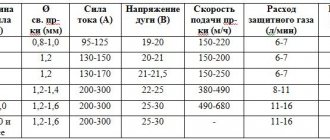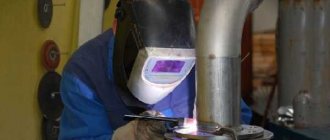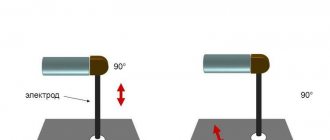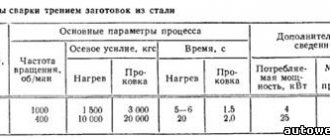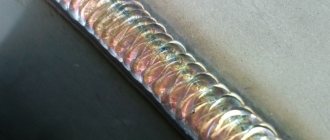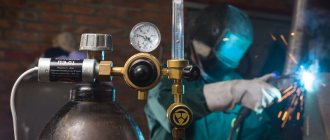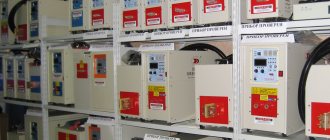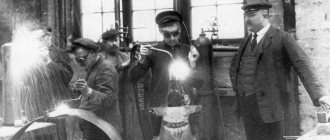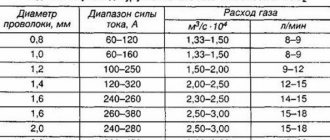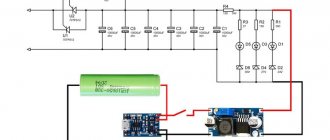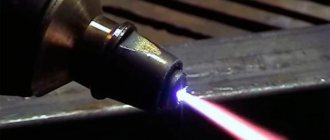What should you consider when welding aluminum?
Welding aluminum is complicated by the specific properties of the metal. For a quality connection, the following nuances must be taken into account:
- Oxide film. It is formed when metal comes into contact with oxygen in the air. The problem is the large difference between the melting temperatures of aluminum and film: 650 and 2000 °C, respectively. As a result, the oxide remains in the weld, creating its heterogeneity. Aluminum can only be welded efficiently by removing the oxide and excluding contact of the metal with oxygen.
- Low melting point and high melt fluidity. It causes rapid flow of molten metal from the welding zone and through burning of the workpiece. Aluminum begins to enter the liquid phase already at a temperature of 500-520 °C.
- Increased volumetric shrinkage coefficient. An incorrect temperature regime causes stress to appear in the seam, which leads to cracking in it and the seam zone, as well as to deformation of the part.
- High thermal conductivity of aluminum. When welding, the loss of thermal energy increases significantly, which quickly spreads throughout the workpiece. This requires increasing the power of the device.
- Fast crystallization. This property of aluminum leads to the appearance of gas pores in the weld due to incomplete gas release during rapid hardening of the metal.
- Aluminum practically does not change color when melted, which makes visual control of the process difficult.
All these features should be taken into account by a novice welder. Setup requires special care.
Is it possible to weld aluminum with direct current - ccm-msk.ru
Lightweight silver aluminum has long become an indispensable material in many areas of human activity. This practical metal or its alloys are used to create aircraft and dishes, huge ships and car parts.
And in order to manufacture or repair the necessary parts, argon welding of aluminum is used. This method, according to most experts, is the most convenient. Read our article and you will find out why this happens.
welding of aluminum and its alloys at home using an inverter - technology
Aluminum has a long list of advantages; it is not for nothing that it is widely used in aircraft construction. But it has one drawback - it is difficult to weld. Therefore, welding of aluminum and its alloys is the domain of highly qualified welders.
Low weldability of aluminum - what's the matter?
The low weldability of aluminum alloys is due to a number of their qualities.
- An oxide film that covers aluminum and its alloys. Its melting point is 2044C, and the melting point of the metal itself is 660C.
- The high fluidity of the molten metal makes it difficult to control the weld pool, for which it is necessary to install special heat-dissipating pads.
- When heated, hydrogen begins to escape from aluminum, which, after the metal hardens, leaves pores and cracks in its body.
- High shrinkage rate. And this leads to deformation of the welding seam during its cooling.
- The thermal conductivity of aluminum alloys is higher than that of steel, so a current is used to weld them, which is higher in strength than the current for welding steel structures. The difference is about twofold.
- If we talk about welding aluminum with our own hands in a home workshop, then most likely you will not come across pure aluminum. Most likely, it will be an alloy of an unknown brand (duralumin and others), for which, when welding, you will have to adjust the welding mode and select additional materials.
Source: https://ccm-msk.ru/mozhno-li-varit-alyuminiy-postoyannym-tokom/
Aluminum welding methods
Aluminum can be welded in several ways:
- Electrode welding (MMA). Electrodes used are UANA, OZANA, OZA-1 and -2, OK 96.10 and 96.50. The method is used in low-critical structures and with a metal thickness of at least 4 mm. The main disadvantage is insufficient uniformity of the seam, porosity, and reduced strength.
- Semi-automatic or electric arc welding. Wire with filler material is constantly fed into the welding zone. The connection is ensured by an electric arc. The oxide film is destroyed by cathode sputtering provided by alternating current or direct current with reverse polarity.
- Welding in argon environment. The most common method is argon arc welding. The gas creates an inert environment without oxygen, which eliminates the formation of an oxide film. An arc is ignited between the tungsten electrode and the workpiece. Aluminum wire is fed into the welding zone.
Interesting: Description of forward and reverse polarity when welding
The choice of method depends on the specific welding requirements and conditions, as well as the availability of the necessary equipment.
Aluminum welding technology using argon
With the advent of modern equipment, argon welding has become widely available even for use in domestic conditions. It can be carried out in manual (TIG welding), semi-automatic and automatic mode. Step-by-step instructions will help you weld aluminum with argon for beginners; it will allow you to do everything correctly and efficiently.
What is needed for welding?
Equipment for welding aluminum
To weld aluminum with argon, a novice welder must prepare in advance:
- The current source is a TIG inverter.
- Special argon burner. It is advisable to insert a gas lens (collet holder) into it to purify the gas.
- An argon cylinder and a hose for connecting it to the burner.
- Filler wire. It is selected taking into account the grade of aluminum or alloy. For pure aluminum, rod No. 5356 is recommended; for aluminum with impurities, rod with silicon No. 4043 is recommended.
- Tungsten electrodes. Recommended brands: WT 20 (has a red tip), WC 20 (gray tip) or WL 15 (yellow tip). The minimum electrode diameter is 2.4 mm.
Important! The inverter should be selected with the following functions: non-contact ignition, crater filling, current regulation.
How to properly prepare aluminum?
High-quality welding of aluminum is possible only after careful preliminary preparation of metal blanks. First of all, it is necessary to clean the surface of the parts from dirt, grease, machine oils and oxide film. Mechanical and chemical cleaning methods can be used.
The mechanical method involves the use of sandpaper, a scraper or a wire brush. It is best to use a special brush for aluminum with stainless wires with a diameter of no more than 0.15 mm. It should not be used on other metals to avoid leaving particles on it.
Chemical cleaning can be done with alcohol, acetone or special solvents. This composition has proven itself well: a solution of sodium hydroxide (50 g) and sodium fluoride (45 g) in water (1 l). After treatment with this solvent, the surface remains clean for up to 4 days.
Immediately before welding, aluminum workpieces should be thoroughly heated (calcined). To do this, they are heated to a temperature of about 300 °C for 20–30 minutes.
Interesting: Main types of metal welding
Preparations require the edges of the workpieces to be welded. If the metal thickness is more than 4 mm, they must be cut for butt welding. It is better to clean large irregularities with a grinder or file.
Preparing argon for welding
The preparation of argon for welding is important. The gas cylinder is installed at a safe distance and must be equipped with a pressure reducer. When purchasing, you should choose pure argon, without air impurities.
It is recommended to install a collet holder in the torch. It has a mesh that provides additional purification of the gas before it is supplied to the welding zone.
Gas flow is adjusted. It depends on the diameter of the filler wire. For Russian-made argon, the following flow rate is set: with a diameter of up to 1 mm - 12-14 l/min, with 1.2 mm - 14-16 l/min, with 1.6 mm - up to 22 l/min. When using Czech-made gas, the flow rate is 7–10 l/min.
Aluminum argon welding process
Tig welding scheme
A novice welder should follow these step-by-step instructions:
- After all the preparatory work has been completed, the selected electrode with a diameter of 2.5–5.5 mm is inserted into the burner. Its overhang should be about 2 mm. The key to ensuring the desired arc is good sharpening of the electrode.
- Excitation of the welding arc. The torch with the electrode is taken in the right hand, and the filler rod (wire) is taken in the left hand. The electrode is brought to a short distance to the surface of the workpiece (2–3 mm), sufficient for an arc to occur. You cannot touch the metal with the electrode, because... I'll have to sharpen it again. The torch is held vertically and the arc is directed towards the beginning of the seam. By changing the distance between the electrode tip and the metal, you can change the size of the arc.
- Formation of a weld pool. It is achieved by melting aluminum wire. It should be applied after ensuring a stable arc. It is generally accepted that the number of seconds required to form a weld pool coincides with the thickness of the workpiece (in mm).
- Formation of the weld. After the formation of the weld pool, regular wire feeding and smooth movement of the torch along the workpiece joining line are ensured. The electrode is held at an angle of 60-80°, and the filler rod - 10-30°. It is desirable that the angle between the torch and the wire is about 90°. The seam is formed according to the “drop by drop” principle, which means you need to ensure that they are distributed differently and are of the same size.
- Finishing the seam. The last stage is filling the crater. The main goal is to get rid of toxins. To do this, the wire feed is reduced and the speed of the electrode is increased. The weld pool should gradually disappear.
Important! The work is completed by checking the strength of the connection and visual control of the quality of the seam.
Rules for holding the electrode and filler wire
Manipulating a TIG torch
Many models of welders for argon-arc welding provide two types of arc ignition - contact and high-frequency. The second option is optimal both for experienced welders due to its convenience, and for beginners who do not want to take risks due to the likelihood of incorrect process settings. High-frequency ignition of the arc does not allow burning through the workpiece, does not leave tungsten particles on it and does not contaminate the electrode itself. In addition, the performer gets the opportunity to clearly control the distance between the electrode and the surface of the structures being welded.
Some recommendations for burner position. If TIG welding of metals is carried out without the use of a filler rod, the nozzle should be kept perpendicular to the plane being welded. If an additive is used, the angle should be selected within 70°-80°. The rod should be positioned at an angle to the workpiece of 15°-20° and perpendicular to the plane of the nozzle. The recommended length of the welding arc should not be more than 3 mm.
The filler wire should be supplied to the working area only after the formation of the weld pool - not earlier and not later. If you are late, there is a risk of burning the workpiece. This skill will require some experience to master. Therefore, beginners will need to practice it on samples.
Upon completion of work, the burner should not be removed immediately. By blowing the working area with inert gas, the contractor ensures that there are no hidden defects in the seam.
All of the above must be performed with strict adherence to the safety rules applicable to any welding process. And if you are still thinking about which welding machine for TIG welding to purchase, we recommend that you familiarize yourself with our catalog. We offer you a wide selection of the best welders for connecting elements made of non-ferrous and ferrous metals in an argon environment. Products from leading brands at the best prices embody the most modern technological developments.
Welding TIG metals using the best inverters from our online store is the key to high quality work and its high efficiency!
Advantages and disadvantages of welding aluminum with argon
Argon welding technology has the following advantages:
- versatility of the method;
- arc stability;
- formation of a neat seam;
- sufficient strength of the welded joint;
- reducing the heating area;
- economical consumption of gas and additives;
- formation of a seam without impurities and pores.
Interesting: Non-destructive inspection of welded joints using ultrasonic methods
Disadvantages should also be noted:
- the need for special equipment;
- high requirements for setting up the device and preparing workpieces;
- the need to acquire sufficient skills.
Important! In general, welding aluminum in argon provides high quality and strength of the connection, which is especially important in critical structures.
How to set up a argon arc welding machine
Various methods can be used to connect metal products. However, welding has proven itself most of all due to the reliability and strength of the resulting connection. The weld is monolithic and has high mechanical strength.
Today, argon arc welding has become quite widespread. By using argon welding, slag is eliminated and a high quality weld is ensured. This welding method is used for welding products made of non-ferrous metals. It can be used both at home and at work.
Setting up argon welding for aluminum
Setting up the aluminum welding process includes the following steps:
- Setting up the welding machine. The following parameters are set on it: current balance with polarity setting (CLEAN WD.), welding current value (CURRENT), crater filling function (DOWN SLOPE toggle switch) or slow arc decay, gas purge function (POST TIME) for cooling the weld pool and torch .
- Setting up electrodes. The diameter of the electrodes and their projection from the burner are selected correctly.
- Argon flow setting. It depends on the diameter of the filler rod. When welding outdoors, consumption increases.
When setting the modes, the ratios given in the table are used:
| Thickness Al, mm | Current strength, A | Electrode diameter, mm |
| up to 1 | 30–42 | 1,6 |
| 1,1–1,5 | 46–60 | 2,3 |
| up to 2 | 71–80 | 2,3 |
| 3 or more | 90–300 | 3,2–5 |
It is necessary to configure equipment and modes with special care. It is better for novice welders to seek help from experienced specialists.
Safety precautions
When carrying out work, it is necessary to take into account the presence of electric current, a bright glow of the arc, hot metal that can splash, and high temperatures. The welder must wear a special mask with a blue light filter. Gloves that protect your hands from melt splashes and clothing that can protect your entire body from them are required.
Electrical equipment must be reliably protected. It is necessary to use a residual current device and circuit breakers. The gas cylinder is equipped with a pressure reduction reducer. Before starting work, you must study the safety regulations and strictly follow them.
When welding aluminum one has to face difficulties caused by its specific properties. Argon welding, with the right approach and the use of high-quality materials and equipment, ensures a reliable connection.
Equipment
Before starting work, you should prepare the necessary equipment for welding. Features of consumables and devices:
- Electrodes that have a tungsten base. These are non-consumable elements to which alloying additives are added.
- A device that produces welding current. It is advisable to choose universal equipment that is suitable for performing a variety of welding jobs.
- Shielding gas cylinder. In this regard, it is most effective to use argon.
Special hoses and wires are used to connect the equipment.
